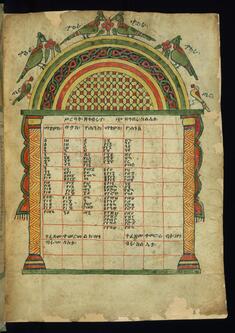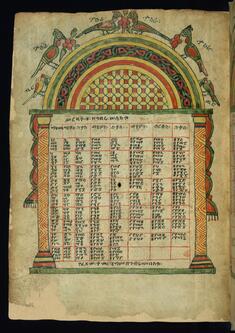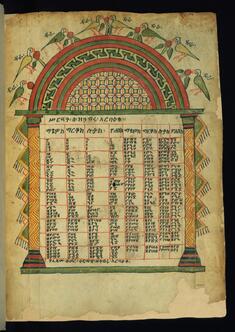Ethiopian canon tables
(Byzantium and Early Russia, Manuscripts and Rare Books, Ethiopia)
This fragmentary manuscript, comprised of four canon tables spread over one bifolium, would originally have been the introductory pages of a fourteenth- or early fifteenth-century Gospel book. Written in the Lake Tana region of Ethiopia, the pages contain canons I-V, which relate the concordance of the Gospels through a chart in which each number corresponds to a Gospel passage, a system originally created by Eusebius of Caesarea in the early fourth century. The numbers here, in keeping with a long tradition, are placed within an arcade of brightly decorated columns and arches. Common within Ethiopian canon table decoration are the curtains, which hang from the sides of the columns, and the interlace-filled arches adorned with birds. These pages provide an excellent example of Ethiopian canon table illumination from the early Solomonic period.
Provenance
Provenance (from the French provenir, 'to come from/forth') is the chronology of the ownership, custody, or location of a historical object. Learn more about provenance at the Walters.
Mr. and Mrs. Joseph Knopfelmacher, New York, acquired in Addis Ababa ca. 1960; Walters Art Museum, 1996, by gift.
Exhibitions
| 2006-2007 | Angels of Light: Ethiopian Art from the Walters Art Museum. Birmingham Museum of Art, Birmingham; Smith College Museum of Art, Northampton; Museum of Biblical Art, New York. |
Geographies
Ethiopia, Lake Tana (Place of Origin)
Measurements
H: 13 9/16 x W: 10 1/16 in. (34.5 x 25.5 cm)
Credit Line
Gift of Mr. and Mrs. Joseph Knopfelmacher, 1996
Location in Museum
Not on view
Accession Number
In libraries, galleries, museums, and archives, an accession number is a unique identifier assigned to each object in the collection.
In libraries, galleries, museums, and archives, an accession number is a unique identifier assigned to each object in the collection.
W.838







